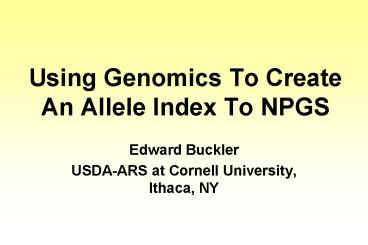Using Genomics To Create An Allele Index To NPGS - PowerPoint PPT Presentation
1 / 15
Title:
Using Genomics To Create An Allele Index To NPGS
Description:
The least proven technology is the gene space discovery, but ... Identification of lines carrying rare alleles of large effect. Encourage extensive phenotyping ... – PowerPoint PPT presentation
Number of Views:117
Avg rating:3.0/5.0
Title: Using Genomics To Create An Allele Index To NPGS
1
Using Genomics To Create An Allele Index To NPGS
- Edward Buckler
- USDA-ARS at Cornell University, Ithaca, NY
2
What do we want to do?
- We want to make more useful plants by conserving,
finding and combining better alleles.
The National Germplasm conserves 464,000
accessions and may contain 100,000,000 distinct
alleles, but there is no index.
3
Yield (CA) Disease Resistance Flavor
Available Germplasm
Although poor yielding, it has complementary
yield QTL and good disease resistance and flavor
Although good yielding, the current line already
captures these QTL
Absolute View
Good QTL
Neutral QTL
Bad QTL
4
Yield (CA) Disease Resistance Flavor
Current Variety DGL 2343
3
0
-2
Available Germplasm
PI 265443
-1
2
3
0
1
0
PI 532443
-1
2
1
PI 783472
0
0
-1
PI 572811
Contrast View
Good QTL
Neutral QTL
Bad QTL
5
Yield (CA) Disease Resistance Flavor
Available Germplasm
7
7
6
Optimal Result
Absolute View
Good QTL
Neutral QTL
Bad QTL
6
How do we build this interface?
- Map QTL controlling agronomic traits.
- Genotype the NPGS germplasm for QTL
7
QTL mapping approaches now exist for virtually
all types of populations.
- Near gene level resolution achieved in multiple
species - Identification of genes controlling flowering,
starch, nutrients, wood quality - Positive Results in
- Maize
- Rice
- Arabidopsis
- Conifers
8
Nested Association Mapping (NAM)
- 25 nested mapping populations being created in
maize - Permit simultaneous genome scan, allele mining,
and high resolution mapping - Best results require high density of markers
(near 100 LD with QTL) - Simulation
- Marker data is real and at very high density
- QTL effects simulated
- Geometric distribution of 50 QTL with 60 h2
9
NAM QTL detection power
- 35 of 38 largest QTL (prop of variation gt0.2)
are detected to the causative SNP or LD block - Best to sample across populations
- 3000-3500 RILs is enough to detect most of the
QTL - This number is closely related to h2
Subsample across pops
Increase of pops
Pop 0 5 10 15
20 25
10
What could genomics do?
- Discover gene space and SNPs
- Focus on genera with 500 accessions that have
some intermating - Randomly sequence gene enriched space for 24
lines (480Mb of total sequence) - Depending on diversity 100K to 2M SNPs
- Score 50,000-400,000 SNPs on each accession
- Enough markers to map in most populations
- Array or bead-chip based SNP discrimination
techniques
11
What will this cost?
12
Who should do this?
- USDA-ARS In-House
- DNA Extraction
- Phenotyping (ongoing)
- Database design and warehousing
- Analysis
- Peer Reviewed Competitive Proposal (Private
and/or Public consortia) - Gene space/SNP discovery and data curation
- SNP genotyping and data curation
- Implementation of analysis algorithms and software
13
When?
Will it work?
- The least proven technology is the gene space
discovery, but discovery is already underway in
genera that represent 60 of the accessions - Mapping resolution will be affected by LD
structure, but this should work for most species - Mapping shortcomings in some genera will still
provide all the necessary information to design
powerful follow-up studies
14
What would this provide?
- Knowledge of relatedness
- Improve curation of germplasm banks
- Informed choice of germplasm core sets
- Facilitate mapping
- Integration with other mapping projects
- Identification of common allele effects
- Identification of lines carrying rare alleles of
large effect - Encourage extensive phenotyping
- Index for the library of alleles that can be
applied to breeding
15
How would this change breeding?
- Informed choice of germplasm to initiate breeding
- Knowledge of valuable new alleles with phenotypic
effect estimates - Markers for any purpose
- Marker assisted breeding becomes a reality for
many species - Still need better methods for combining 10s and
100s of QTL































